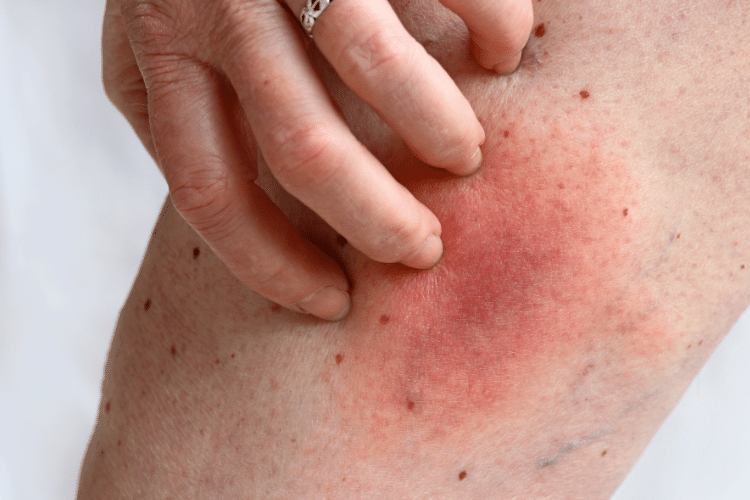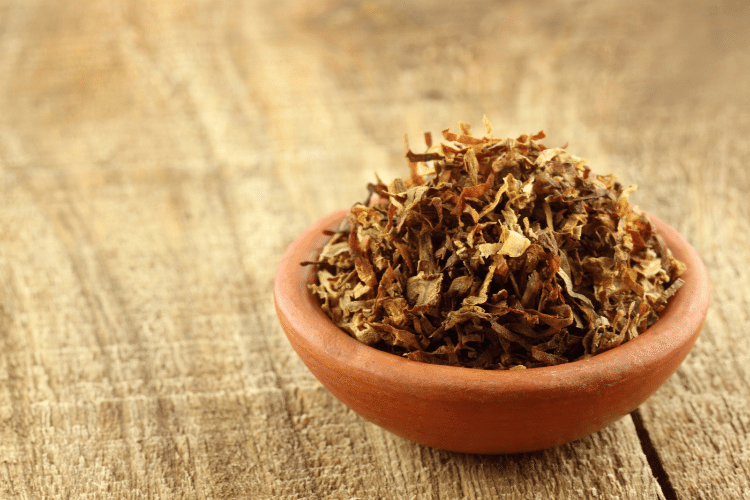Bees are highly beneficial and productive fellow earth inhabitants. They’re peaceful for the most part, but if you make them angry -unintentionally or not-, you’re likely in for a painful sting.
Various home remedies can treat bee stings, one of which is the juice of a cigarette!
Keep reading to find out how tobacco on bee stings can help alleviate discomfort, how to apply it, and alternative ways to cure bee stings.
Does Tobacco Help Treat Bee Stings?
Tobacco is a plant that contains nicotine as the primary active constituent. It’s primarily used in cigarettes and is the culprit behind their soothing effect.
Among tobacco’s less conventional uses is treating bee stings. This application has been around for a while, particularly in the South.
Many people nowadays have stories involving their grandmas and grandpas somehow using tobacco on their skin when they’d get bitten by insects as children.
How right were those grandparents to do so? Does tobacco really help with bee stings?
Well, it seems so. Many people do recall feeling better after having tobacco paste slapped on their bee stings. Many people use the same method to this day.

How Does Tobacco Help with Bee Stings?
As mentioned above, there’s no conclusive scientific evidence that supports the ability of tobacco paste to cure a bee sting or alleviate its symptoms of pain, swelling, redness, and itching.
That said, the nicotine in tobacco may possess a local anesthetic effect. This action has been studied in mice where the results suggest that nicotine can cause insensitivity to pain.
As such, it’s possible that applying tobacco to the skin can produce a sedating or numbing effect, which helps soothe the pain and discomfort of a bee sting.
Following this idea, tobacco can also treat bites of other insects such as hornets, wasps, and horse flies.
How to Use Tobacco on Bee Stings
The most common source of tobacco used in bee sting remedies is cigarettes, but you can also get it from cigars, chewing tobacco, snuff tobacco, dissolvable, and so on.
It doesn’t matter what type of tobacco you’re using as long as you make sure it’s dry and hasn’t developed mold.
- Note: don’t use a menthol cigarette unless you want the stung skin to burn!
Once you get your hands on tobacco, wet it a bit to create a paste. If you have thick pieces of tobacco, you can use a rock or another solid object to crush them into a small-enough size.
Apply the tobacco paste on the sting without rubbing to avoid scratching the skin with the tobacco bits. From there, wait for at least 5 minutes.
If you’re using a cigarette, you can alternatively dunk its end a few times in water and then squeeze out some of the juice. Gently rub the liquid on the sting (without scratching!) and wait for a few minutes for the anesthetic action to kick in.
How Much Tobacco to Use and How Long to Leave it
The amount of tobacco to use and the time you need to leave it on the affected area of the skin varies depending on the severity of the pain and the extent of the body’s reaction to the bee sting.
Generally speaking, tobacco paste takes between 5 to 15 minutes to produce its numbing effect.
If you still feel pain after that long, tobacco paste probably isn’t for your case so you should remove it from the sting’s site and try another remedy or contact your doctor.

Alternative Home Remedies to Treat Bee Stings
Treating a bee sting usually calls for a combination of proper first aid and home remedies.
Traditional first aid includes the following steps:
- Use a piece of gauze or your fingernails to quickly remove the stinger because it’ll continue to release venom into the blood while stuck in the skin. Ideally, you want to scrape or brush the stinger out, but you may have to pull or pinch it out.
- Wash the affected area with water and soap to get rid of lingering germs that might cause an infection.
- Avoid scratching the sting site to prevent potential infections.
After these first-aid steps, consider the following home remedies to treat bee stings instead of tobacco:
1. Ice
Applying an ice pack to the sting site can help reduce the swelling and pain sensation as it decreases the flow of blood to the affected area.
Let the cold compress sit on the skin for no longer than 20 minutes. Don’t place ice directly on the skin to avoid burns.
2. Honey
Offering antiseptic and wound-healing effects, honey can help alleviate symptoms of bee stings. According to recent research, honey demonstrates antimicrobial properties and can reduce inflammation.
You can use regular household honey or Manuka honey for bee stings by applying a small amount to the problematic area and then covering it loosely with a bandage. Let the honey sit for up to 1 hour.
3. Apple Cider Vinegar
Many health benefits are associated with apple cider vinegar, including reducing inflammation and preventing infection. As such, using it on bee stings may help relieve symptoms.
You can use cotton balls or a clean cloth doused in apple cider vinegar to soak the sting site for no shorter than 15 minutes.
4. Aloe Vera
Derived from aloe plants, aloe vera is proven to possess anti-inflammatory, wound-healing, and soothing properties.
You can make it at home if you have the plant by breaking off a leaf and squeezing the gel. You can also buy an aloe vera gel online or from any pharmacy or department store.
Apply the gel directly to the sting site and let your skin soak it up.
5. Baking Soda
The CDC (Centers for Disease Control and Prevention) recommends applying baking soda paste to mosquito bites to reduce itching and swelling. Similarly, it can be beneficial in treating bee stings.
Mix baking soda with a teaspoon of water to form a thick paste and then set it on the affected site. Rinse the paste off after 10 minutes or cover it loosely with a bandage and leave it for 15 minutes.
6. Toothpaste
Bee venom is acidic, so there are claims that alkaline toothpaste can alleviate bee stings by neutralizing them.
It’s pretty easy to use; just dab some toothpaste on the sting site and wipe it off after 15 to 20 minutes. Avoid using mint toothpaste as it can burn.

7. Witch Hazel Extract
Witch hazel is a plant commonly featured in folk medicine throughout the United States, particularly the Hamamelis virginiana species. Its extract can fight inflammation, soothe irritated skin, and prevent infection.
You can apply witch hazel extract directly to the affected area.
8. Calendula Oil
Marigold flowers are the source of calendula oil, which possesses antibacterial, antifungal, anti-inflammatory, wound-healing, and soothing properties. As such, it can be a great help when treating bee stings.
Apply calendula cream or ointment directly to the affected area and then cover it with a bandage.
9. Tea Tree Oil
Thanks to its antiseptic and anti-inflammatory effects, tea tree oil can be beneficial for bee stings. It can promote wound healing and reduce itchiness.
Mix tea tree oil with a carrier oil for dilution (such as olive, jojoba, or coconut oil) and then dab a few drops of the concoction directly on the affected area.
10. Lavender Oil
Similar to tea tree oil, lavender oil has anti-inflammatory, antibacterial, and soothing properties. Applying it to the skin (after mixing it with a carrier oil) can help alleviate bee sting symptoms.
Are Bee Stings Dangerous?
In most cases, bee stings are just a hassle. They cause mild reactions consisting of burning pain, redness, and swelling at the sting site, but nothing too serious that a home remedy can’t fix up.
However, bee stings can be dangerous if you develop a more serious reaction because you’re allergic or have been stung multiple times.
A moderate reaction shows extreme swelling and redness at the sting site, whereas a severe reaction involves intense itching, swelling of the tongue/throat, difficulty breathing, dizziness, nausea/vomiting, and fainting.
The majority of bee sting cases don’t require a visit to the doctor and will resolve within a few hours up to 10 days. But if you’re suspecting a serious anaphylaxis-level reaction, you should seek immediate medical attention.
Wrapping Up
Tobacco on bee stings can be effective thanks to the anesthetic effects of nicotine, which helps numb the pain and discomfort at the affected site. Simply wet tobacco bits to form a paste and apply it to the sting site for 5 to 15 minutes.
Alternatively, you can use ice, honey, apple cider vinegar, aloe vera, baking soda, or toothpaste. You can also try other plant extracts such as witch hazel, calendula, tea tree, and lavender.
Keep in mind that neither tobacco nor any other home remedy should increase pain, swelling, redness, or itchiness at the sting site. If this happens, rinse the affected area with soapy water and switch to a different remedy.
- Does Bleach Kill Bees? - April 23, 2024
- How Do I Get Rid of Ants Without Harming Bees? - April 16, 2024
- Do Bug Zappers Kill Bees? Completely Explained - April 9, 2024
